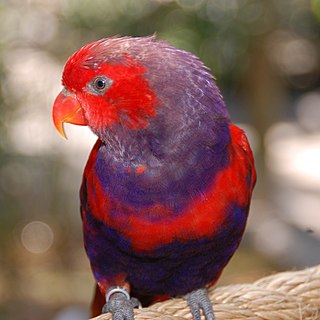
The sargassum fish, anglerfish, or frog fish is a frogfish of the family Antennariidae, the only species in its genus. It lives among Sargassum seaweed which floats in subtropical oceans. The scientific name comes from the Latin histrio meaning a stage player or actor, and refers to the fish's feeding behaviour.

The red-and-blue lory is a small, strikingly-colored parrot endemic to Indonesia. The species inhabits a single island, Karakelang, in the Indonesian archipelago.

Stereocyclops histrio is a species of frog in the family Microhylidae. It is endemic to the northeastern Bahia state of Brazil where it occurs in remnants of the Atlantic forest. After the holotype was collected in 1944, the species went unrecorded until a population was found in the Una Biological Reserve and its surroundings in 1999. It is now known from four locations. Common name Bahia yellow frog has been coined for it, perhaps in reference to the bright lemon yellow coloration of the holotype. It was the only species in the genus Hyophryne until 2012 when molecular data demonstrated that it is nested within Stereocyclops species.

Eos is a genus of parrots belonging to the lories and lorikeets tribe of the family Psittaculidae. There are six species which are all endemic to islands of eastern Indonesia, most within very restricted ranges. They have predominantly red plumage with blue, purple or black markings. Males and females are similar in appearance.

Gobiodon histrio, the Broad-barred goby, is a species of goby native to the Indian Ocean from the Red Sea to the western Pacific Ocean to southern Japan, Samoa and the Great Barrier Reef. This species is a reef dweller, being found at depths of from 2 to 15 metres. It can reach a length of 3.5 centimetres (1.4 in) TL. This species can also be found in the aquarium trade.
Terebra histrio is a species of sea snail, a marine gastropod mollusk in the family Terebridae, the auger snails.
Vexillum histrio is a species of small sea snail, a marine gastropod mollusk in the family Costellariidae, the ribbed miters.

Mauritia histrio, common name the harlequin cowry or the stage cowry, is a species of sea snail, a cowry, a marine gastropod mollusk in the family Cypraeidae, the cowries.

Aglaomorpha histrio is a moth of the family Erebidae. It is found in Korea, Japan, China and Taiwan.
Chetone histrio, or Boisduval's tiger, is a moth of the family Erebidae. It was described by Jean Baptiste Boisduval in 1870. It is found in Honduras, Guatemala and Peru. The habitat consists of rainforests and cloudforests at elevations between 500 and 2,000 meters on the eastern slopes of the Andes.

Iris histrio is a species in the genus Iris, it is also in the subgenus of Hermodactyloides and Section Reticulatae. It is a bulbous perennial from Central Asia: Kyrgyzstan. Israel, Lebanon, Syria and southern Turkey.
Thyreus histrio, is a species of bees belonging to the family Apidae subfamily Apinae.
Serixia is a genus of longhorn beetles of the subfamily Lamiinae, containing the following species:

Mastax histrio is a species of beetle in the Carabidae family that can be found in India, Pakistan and Sri Lanka.
Serixia buruensis is a species of beetle in the family Cerambycidae. It was described by Stephan von Breuning in 1958.
Serixia prolata is a species of beetle in the family Cerambycidae. It was described by Francis Polkinghorne Pascoe in 1858.
Serixia sedata is a species of beetle in the family Cerambycidae. It was described by Francis Polkinghorne Pascoe in 1862.
Serixia phaeoptera is a species of beetle in the family Cerambycidae. It was described by Per Olof Christopher Aurivillius in 1927.

Pamphilius histrio is a species of leaf-rolling sawflies within the Symphyta belonging to the family Pamphiliidae.

Parancistrocerus histrio is a species of stinging wasp in the family Vespidae.











